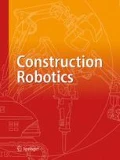As our means of production change with new technologies, so will our architectural designs for built environment. One might look at engineering as the art of solving problems within the bounds of the technologically and physically possible and architectural design as the art of shaping the world according to the needs and intent of human beings.
Yet design is not a subset of all that is made possible through engineering. At times good design may lie outside of the currently possible. This is why it is so essential for our disciplines to come together on a common platform to share ideas and to solve the challenge of Construction Robotics. I hope that this new journal can play a part in this endeavor and am, therefore, exceedingly happy that the communities of both Robots in Architecture and euRobotics have supported the creation of this new journal with such enthusiasm.
The resulting first issue illustrates quite aptly the two main challenges at hand. The first four articles cover various approaches on bringing robots onto the construction site and delve into issues of hardware design, path planning and material-adaptive process design. The latter four articles show the realm of possibilities in pre-production, ranging from the fabrication of complex assemblies and geometries to the restoration of historic buildings. Across these areas the articles exhibit both the value of the ubiquitous industrial robot as a technological stepping stone as well as the necessity for the development of novel robot architectures suited for the construction site of tomorrow.
The publication of Construction Robotics would not be possible without the tremendous work contributed by the authors, reviewers and editorial team. I would like to take the opportunity to express my thanks to them and look forward to continuing in this shared endeavor.
Author information
Authors and Affiliations
Corresponding author
Rights and permissions
About this article
Cite this article
Brell-Cokcan, S. Editorial. Constr Robot 1, 1 (2017). https://doi.org/10.1007/s41693-017-0009-z
Published:
Issue Date:
DOI: https://doi.org/10.1007/s41693-017-0009-z

